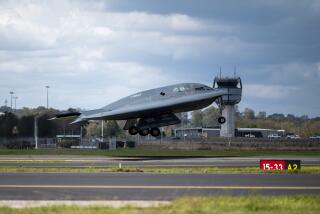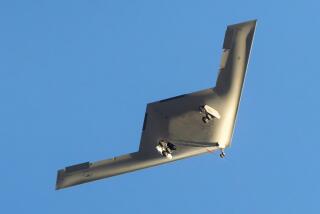Going With the Grain : Before a New Paint Job, Northrop’s B-2s Get Special Starch Treatment
- Share via
Athletes eat their Wheaties to keep in top shape. Now Northrop Grumman Corp. is relying on wheat starch to keep B-2 bombers in prime physical condition as well.
The Los Angeles company that makes the stealth bombers uses grains of wheat starch to strip old paint off the planes before a fresh coat is applied. A typical B-2 will be stripped and repainted four times during its lifetime, and the B-2 fleet is in the midst of its first repainting cycle.
Airplanes of all sorts are usually cleaned with a chemical stripper that loosens paint from metal. But B-2 bombers are made of carbon composites and can be damaged by those chemicals, which are also hazardous to the environment, said Carl Johnson, manager of the modification line for the B-2 at Northrop’s facility in Palmdale.
The main alternative is to use small, abrasive balls of plastic to scrape paint off a plane. But wheat starch does less damage to the B-2’s skin because the grains’ fine, salt-like surfaces do a more precise job of cutting away the old paint, Johnson said. The wheat starch is reused as many as eight to 10 times and contains no hazardous elements.
Wheat starch has been used to strip paint off small parts at the machine shops that supply the aerospace giants. But Northrop engineers had to develop a new cleaning method to accommodate a plane as big as the B-2, which has 10,000 square feet of surface area and is roughly the size of a Boeing 737 jetliner.
Johnson said all of the “major U.S. aircraft manufacturers” have contacted Northrop about adopting the environmentally friendly process, as have other contractors for the Air Force and NASA.
So far, 10 of the 19 B-2s have been through the wheat-starch process. The new coats of paint are expected to last at least two or three years.
Boeing Makes Goodwill Trips
Boeing Co. executives have been shuttling to Southern California to meet with McDonnell Douglas workers in advance of the two companies’ $15.5-billion merger, which is scheduled to close Aug. 1.
Ron Woodard, president of Boeing’s commercial airplane group, and other executives have visited Long Beach and Huntington Beach in recent weeks to break the ice.
Although the Boeing emissaries are tight-lipped about specifics for the soon-to-be-combined company, the jobs of about 5,000 manufacturing workers at Douglas Aircraft Co. in Long Beach are considered among the safest. Even if McDonnell Douglas airplanes are discontinued, Seattle-based Boeing will almost certainly use the Long Beach facility to fill orders of its more popular models, according to a Boeing spokeswoman.
Indeed, Douglas Aircraft workers are among those most receptive to the merger. With McDonnell Douglas’ share of the commercial airplane market in the 6% range, workers say they believe their jobs are safer under the Boeing umbrella. Besides, many of them still harbor ill feelings toward McDonnell--which acquired Douglas 30 years ago--and are only too happy to see the St. Louis company get a taste of its own medicine, courtesy of Boeing.
A Little Help From Congress
U.S. Rep. Ron Packard (R-Oceanside) is urging the Federal Aviation Administration to expedite its certification of the MD-17, a commercial version of the popular C-17 military transport plane that McDonnell Douglas makes in Long Beach. The request was written into the transportation appropriations bill and easily cleared the Appropriations Committee last week. The full House is scheduled to take up the spending bill next week.
That’s quite a rousing endorsement, considering McDonnell Douglas does not yet have any customers for the commercial cargo plane. In March, the company cleared the way to build the first two MD-17s; it expects to sell as many as 50 around the world. The only commercial cargo plane for oversize loads flying today is the Russian Antonov AN-124.
Separately, the Appropriations Defense Subcommittee in the Senate added two C-17s to the Defense Department’s 1998 shopping list.
Karen Kaplan covers aerospace and technology. She can be reached at Karen.K[email protected].
More to Read
Inside the business of entertainment
The Wide Shot brings you news, analysis and insights on everything from streaming wars to production — and what it all means for the future.
You may occasionally receive promotional content from the Los Angeles Times.











